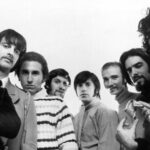While some might pigeonhole roots music, the vibrant vocal harmony style known as doo-wop, born in African American communities in the late 1940s, deserves its place within the broad spectrum of Americana. Emerging from urban centers like New York, Chicago, and Philadelphia, doo-wop songs resonated far beyond their initial neighborhoods. My own introduction to this genre came through the crackling signal of a small radio station across the Delaware River, hosted by the legendary DJ Jerry “Geator With The Heater” Blavat, a champion who helped bring doo-wop’s captivating sound to suburban ears.
Drawing inspiration from the close harmony styles popularized in the 1930s and 40s by groups like the Ink Spots and the Mills Brothers, young Black teenagers forged their own path. Street corners, school gyms, and subway stations became their impromptu studios, as they sang a cappella, striving to craft a sound that could unlock their piece of the American Dream. Music scholar Frank Hoffmann, in his Survey of American Popular Music, meticulously breaks down the core elements of this genre:
“Group harmony, a wide range of vocal parts, nonsense syllables, a simple beat, light instrumentation, and simple music and lyrics. Above all, the focus is on ensemble singing. In doo-wop vocal harmonies the echo runs underneath the lead vocalist. Generally, the second tenor and baritone blend together as one sound, with the high tenor (or falsetto) running over the lead and the bass reverberating on the bottom end. The group harmony does not usually lead throughout; however, it may occasionally alternate with a tenor in this capacity.”
The characteristic “nonsense syllables” – a hallmark of doo-wop songs – were ingeniously derived from various sources: the improvisational scat of bop and jazz, the rhythmic patterns of West African chants, the a cappella tradition of street corner singing (serving as a vocal bassline), and the burgeoning R&B scene of the early 1950s. These syllables, as Hoffmann notes, were not merely random sounds but integral components of the harmony, often employed in bass and harmony parts, becoming more restrained and somber in ballads.
Hoffmann further categorizes the evolution of doo-wop into distinct stylistic periods: Paleo (1952-54), Classical (1955-59), and Neo (1960-1963). While independent record labels initially nurtured the genre, major labels soon recognized its commercial potential. They capitalized by having popular white artists re-record doo-wop hits, aiming for broader appeal. However, teenage audiences overwhelmingly favored the original recordings by African American groups. By 1955, doo-wop songs from groups like The Moonglows, The Flamingos, The Penguins, and The Platters achieved mainstream chart success, playing a pivotal role in ushering in the era of rock and roll.
Expanding on this narrative, Wikipedia highlights the broadening demographics of doo-wop artists:
“1958 saw the rise of Italian American doo-wop groups. Like African-Americans, the Italian Americans generally attended church, where they gained singing experience, and lived in urban neighborhoods, where they would sing on street corners. By the late 1950s, Italian American street corner doo-wop groups were seen in cities such as New York, especially the Bronx and Brooklyn. The contribution of Hispanics is often overlooked. Early, especially in U.S. East Coast cities, Puerto Ricans were lead singers in some groups with black and white members. ‘Racially integrated’ groups with both black and white performers included the Del Vikings, Impalas and Crests.”
The cultural landscape shifted dramatically with the arrival of the British Invasion in 1964, effectively marking the end of doo-wop’s reign on the charts. While some established groups like The Four Seasons, The Drifters, and Little Anthony and The Imperials continued to find mainstream success, many doo-wop artists transitioned to labels like Motown, Stax, and Atlantic, exploring new sonic territories. Despite a brief resurgence with Sha Na Na’s performance at Woodstock and the popularity of 1970s golden oldies revival shows and the American Graffiti soundtrack, the doo-wop era largely faded from mainstream consciousness. However, the enduring Broadway hit Jersey Boys, which premiered in 2005 and ran for many years, rekindled interest in the story of The Four Seasons and, by extension, the doo-wop sound.
Beyond nostalgia-driven performances, doo-wop songs persist as more than just a footnote. They are a foundational element within the rich tapestry of roots music and Americana, a testament to the power of vocal harmony and the enduring quest for the American Dream expressed through music.

